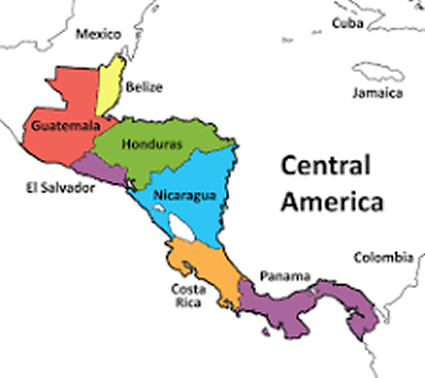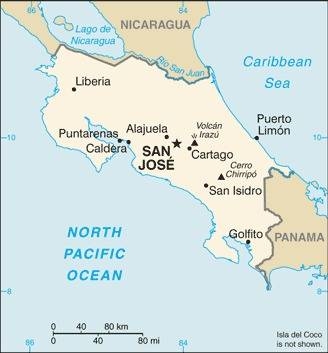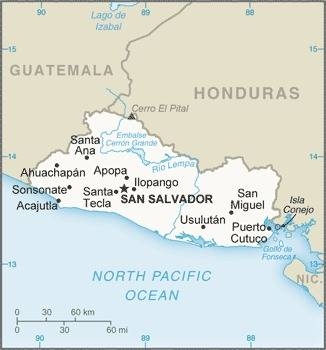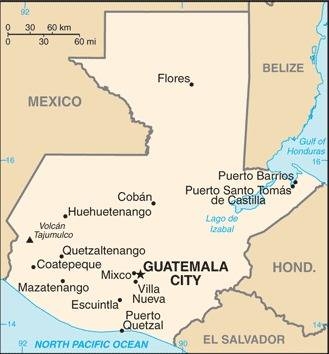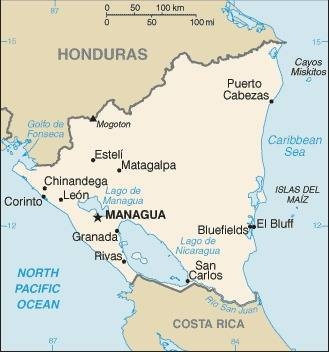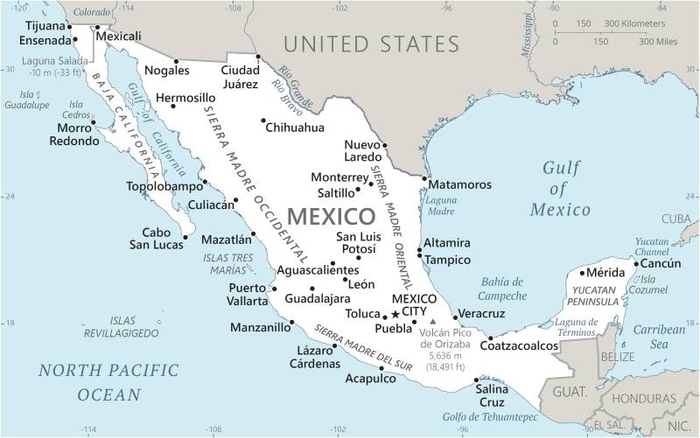Belize
Tourism is the number one foreign exchange earner in this small economy, followed by exports of sugar, bananas, citrus, marine products, and crude oil.
Current concerns include the country's heavy foreign debt burden, high crime rates, high unemployment combined with a majority youth population, growing involvement in the Mexican and South American drug trade, and one of the highest HIV/AIDS prevalence rates in Central America.
Guatemala refused to recognize Belize until 1992 and the two countries are involved in an ongoing border dispute. Both nations have voted to send the dispute for final resolution to the International Court of Justice.
Climate: tropical; very hot and humid; rainy season (May to November); dry season (February to May)
Costa Rica
Tourism
Costa Rica is the most-visited nation in the Central American region,[80] with 2.9 million foreign visitors in 2016, up 10% from 2015.[81] In 2015, the tourism sector was responsible for 5.8% of the country's GDP, or $3.4 billion.
Economy
Since 2010, Costa Rica has enjoyed strong and stable economic growth - 3.8% in 2017. Exports of bananas, coffee, sugar, and beef are the backbone of its commodity exports. Various industrial and processed agricultural products have broadened exports in recent years, as have high value-added goods, including medical devices. Costa Rica's impressive biodiversity also makes it a key destination for ecotourism.
Foreign investors remain attracted by the country's political stability and relatively high education levels, as well as the incentives offered in the free-trade zones; Costa Rica has attracted one of the highest levels of foreign direct investment per capita in Latin America.Military and Security
No regular military forces; Ministry of Public Security: the Public Force (National Police)), Air Surveillance Service, National Coast Guard, Border Police (Policia de Fronteras); Ministry of Presidency: Directorate of Intelligence and Security (DIS), Special Intervention Unit (UEI) (2022)
note: Costa Rica's armed forces were constitutionally abolished in 1949
El Salvador
El Salvador is beset by one of the world's highest homicide rates and pervasive criminal gangs.
In January 2022, the International Monetary Fund (IMF) urged El Salvador to reverse its decision to make cryptocurrency legal tender. Bitcoin had rapidly lost about half of its value, meaning economic difficulties and, as of May 2022, with government bonds trading at 40% of their original value, the prospect of a looming sovereign default. Bukele announced back in January 2022 plans to build a "Bitcoin city" at the base of a volcano in El Salvador.
In 2022, Salvadoran government initiated a massive fight against criminal gangs and gang-related violence. State of emergency was declared on 27 March. It was extended on 20 July. More than 53,000 suspected gang members were arrested, meaning the highest reported incarceration rate in the world
The environment needs some help: deforestation; soil erosion; water pollution; contamination of soils from disposal of toxic wastes
By the early 20th century coffee accounted for 90% of export earnings. El Salvador has since reduced its dependence on coffee and embarked on diversifying its economy by opening up trade and financial links and expanding the manufacturing sector.
Guatemala
Good for volcanologistGuatemala is one of the countries along the Ring of Fire, a belt of active volcanoes and earthquake epicenters bordering the Pacific Ocean; up to 90% of the world's earthquakes and some 75% of the world's volcanoes occur within the Ring of Fire
Numerous volcanoes in mountains, with occasional violent earthquakes; Caribbean coast extremely susceptible to hurricanes and other tropical storms
The climate is hot, humid in lowlands; cooler in highlands
The vast majority of the populace resides in the southern half of the country, particularly in the mountainous regions; more than half of the population lives in rural areas.
Guatemala is the most populous country in Central America with a GDP per capita roughly half the average for Latin America and the Caribbean. The agricultural sector accounts for 13.5% of GDP and 31% of the labor force; key agricultural exports include sugar, coffee, bananas, and vegetables. Guatemala is the top remittance recipient in Central America as a result of Guatemala's large expatriate community in the US. These inflows are a primary source of foreign income, equivalent to two-thirds of the country's exports and about a tenth of its GDP.
Extreme poverty
The investment climate: concerns over security, the lack of skilled workers, and poor infrastructure continue to hamper foreign direct investment.
Poverty among indigenous groups, which make up more than 40% of the population, averages 79%, with 40% of the indigenous population living in extreme poverty. Nearly one-half of Guatemala's children under age five are chronically malnourished, one of the highest malnutrition rates in the world
Honduras
After two and a half decades of mostly military rule, a freely elected civilian government came to power in 1982. During the 1980s, Honduras proved a haven for anti-Sandinista contras fighting the Marxist Nicaraguan Government and an ally to Salvadoran Government forces fighting leftist guerrillas. The country was devastated by Hurricane Mitch in 1998, which killed about 5,600 people and caused approximately $2 billion in damage. Since then, the economy has slowly rebounded, despite COVID and severe storm-related setbacks in 2020 and 2021.
Honduras, the second poorest country in Central America, suffers from extraordinarily unequal distribution of income, as well as high underemployment. While historically dependent on the export of bananas and coffee, Honduras has diversified its export base to include apparel and automobile wire harnessing. Honduras’s economy depends heavily on US trade and remittances
Nicaragua
Trafficking profile: human traffickers exploit domestic and foreign victims in Nicaragua and Nicaraguans abroad; women, children, and migrants are most at risk; women and children are subject to sex trafficking within the country and its two Caribbean autonomous regions, as well as in other Central American countries, Mexico, Spain, and the United States; traffickers used social media to recruit victims with promises of high-paying jobs in restaurants, hotels, construction, and security outside of Nicaragua where they are subjected to sex or labor trafficking; traffickers exploit children through forced participation in illegal drug production and trafficking; children and persons with disabilities are subjected to forced begging; Nicaragua is also a destination for child sex tourists from the United States, Canada, and Western Europe.
Economy
Nicaragua, the poorest country in Central America and the second poorest in the Western Hemisphere, has widespread underemployment and poverty. GDP growth of 4.5% in 2017 was insufficient to make a significant difference. Textiles and agriculture combined account for nearly 50% of Nicaragua's exports. Beef, coffee, and gold are Nicaragua’s top three export commodities.
Nicaraguan aid to leftist rebels in El Salvador prompted the US to sponsor anti-Sandinista contra guerrillas through much of the 1980s. After losing free and fair elections in 1990, 1996, and 2001, former Sandinista President Daniel ORTEGA was elected president in 2006, 2011, 2016, and most recently in 2021.
Politics
Democratic institutions have weakened under the ORTEGA regime as the president has garnered full control over all branches of government, especially after cracking down on a nationwide pro-democracy protest movement in 2018. In the lead-up to the 2021 presidential election, authorities arrested over 40 individuals linked to the political opposition, including presidential candidates, private sector leaders, NGO workers, human rights defenders, and journalists. Only five lesser-known presidential candidates of mostly small parties allied to ORTEGA's Sandinistas were allowed to run against ORTEGA in the November 2021 election.
Panama
With US backing, Panama seceded from Colombia in 1903 and promptly signed a treaty with the US allowing for the construction of a canal and US sovereignty over a strip of land on either side of the structure (the Panama Canal Zone). The Panama Canal was built by the US Army Corps of Engineers between 1904 and 1914. In 1977, an agreement was signed for the complete transfer of the Canal from the US to Panama by the end of the century. Certain portions of the Zone and increasing responsibility over the Canal were turned over in the subsequent decades. With US help, dictator Manuel NORIEGA was deposed in 1989. The entire Panama Canal, the area supporting the Canal, and remaining US military bases were transferred to Panama by the end of 1999. An ambitious expansion project to more than double the Canal's capacity - by allowing for more Canal transits and larger ships - was carried out between 2007 and 2016.
Panama's dollar-based economy rests primarily on a well-developed services sector that accounts for more than three-quarters of GDP. Services include operating the Panama Canal, logistics, banking, insurance, container ports, flagship registry, and tourism and Panama is a center for offshore banking. Panama's transportation and logistics services sectors, along with infrastructure development projects, have boosted economic growth; however, public debt surpassed $37 billion in 2016 because of excessive government spending and public works projects. The US-Panama Trade Promotion Agreement was approved by Congress and signed into law in October 2011, and entered into force in October 2012.
Environment
Water pollution from agricultural runoff threatens fishery resources; deforestation of tropical rain forest; land degradation and soil erosion threatens siltation of Panama Canal; air pollution in urban areas; mining threatens natural resources.
Mexico
Mexico is not so much a country as it is a Quentin Tarantino film set.
Best known as the home of mariachi music and tequila, and base for methamphetamine trafficking by the powerful cartels. Battles arise between these cartels, the New Generation and the Resistance attempting to clear out the old guard like the Sinaloa, leaving hundreds dead in the city. The paramilitary Zetas drug cartel use headline-grabbing atrocities in a national push to seize territory from older organized crime groups. More than 45,000 people have died in drug-related violence in Mexico since 2006
Mexican human rights activists have asked the international criminal court to investigate President Felipe Caldéron, as well as top officials and the country's most-wanted drug trafficker, accusing them of allowing subordinates to kill, torture and kidnap civilians.
Signed by 23,000 Mexican citizens, the complaint names the Sinaloa cartel boss Joaquin "Shorty" Guzman, who has a $5m bounty on his head, as well as the public security minister, Genaro Garcia Luna, and the commanders of the army and navy.
The Mexican government has denied it is "at war" and said the use of the military in its battle against drug gangs is a temporary measure taken at the request of state governments. "The established security policy in no way constitutes an international crime. On the contrary, all its actions are focused on stopping criminal organisations and protecting all citizens," said an interior ministry statement.

